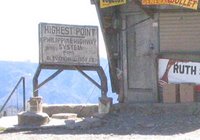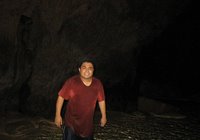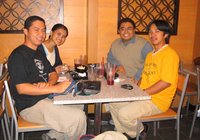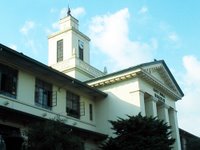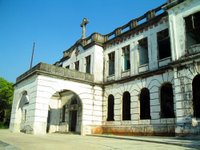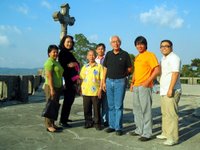 I was up quite early. The group left Pampanga at 5 a.m. and I met up with them in Manila. After breakfast along the SLEX, we were off to our first stop, the town of Pila, Laguna. The historic center of the town, La Noble Villa de Pila, one of the few towns in the country which was elevated to villa during the Spanish colonial period, was declared a national historical landmark by the NHI in 2000.
I was up quite early. The group left Pampanga at 5 a.m. and I met up with them in Manila. After breakfast along the SLEX, we were off to our first stop, the town of Pila, Laguna. The historic center of the town, La Noble Villa de Pila, one of the few towns in the country which was elevated to villa during the Spanish colonial period, was declared a national historical landmark by the NHI in 2000. The old core is an elegant collection of colorful colonial mansions located around a spacious plaza. The layout out of the town is very typical of our colonial communities. On one side of the plaza, you have the parish church. On the opposite end stands Pila's charming town hall painted in brick red. And on the other two sides, you have the homes of the town's principalia. What I like about Pila are the colors. This was how houses were painted during the Spanish and American colonial periods, bright and lively colors, with a palette somewhat similar to Mexican pastel.
The old core is an elegant collection of colorful colonial mansions located around a spacious plaza. The layout out of the town is very typical of our colonial communities. On one side of the plaza, you have the parish church. On the opposite end stands Pila's charming town hall painted in brick red. And on the other two sides, you have the homes of the town's principalia. What I like about Pila are the colors. This was how houses were painted during the Spanish and American colonial periods, bright and lively colors, with a palette somewhat similar to Mexican pastel. The town has a very active heritage conservation group, the Pila Historical Society Foundation, Inc. which has continuously led efforts to preserve the heritage of this genteel town. They even protect the plaza from billboards and tarpaulin streamers. Check out Pila, Laguna: Keeping a heritage town beautiful.
The town has a very active heritage conservation group, the Pila Historical Society Foundation, Inc. which has continuously led efforts to preserve the heritage of this genteel town. They even protect the plaza from billboards and tarpaulin streamers. Check out Pila, Laguna: Keeping a heritage town beautiful.After Pila, we proceeded further down the highway, past the town of Pagsanjan, to Lumban, a town known for its great embroidery. Just like in Taal, I bought piña cloth. I make it a point everytime I visit these embroidery towns to buy barong cloth.
 From there, we were off to Paete and Pakil. But since it was lunch, we stopped over at Exotik Restaurant in Longos, Kalayaan. The concept of this garden restaurant is quite nice and it is thus a good lunch stopover point for those doing the Laguna loop. Although most of the menu is Filipino food, the restaurant got its name from the exotic food they also serve such as snakes, frogs, manta rays, etc.
From there, we were off to Paete and Pakil. But since it was lunch, we stopped over at Exotik Restaurant in Longos, Kalayaan. The concept of this garden restaurant is quite nice and it is thus a good lunch stopover point for those doing the Laguna loop. Although most of the menu is Filipino food, the restaurant got its name from the exotic food they also serve such as snakes, frogs, manta rays, etc.Paete was just 2 kilometers from the restaurant. This town has a well-preserved church with several centuries-old murals inside. And being a wood carving town, the retablo was nicely done. Don't miss the souvenir shops since the town is known for its wood carving and paper mache.
 I was quite delighted looking at the folksy paper mache figures of people in Filipino costumes which was a common theme in public parks during the American colonial period. They reminded me so much of the statues in the rotunda in Carcar. There were also paper mache fruits which looked quite real. Looking closely at each fruit, one would appreciate the effort put into each one.
I was quite delighted looking at the folksy paper mache figures of people in Filipino costumes which was a common theme in public parks during the American colonial period. They reminded me so much of the statues in the rotunda in Carcar. There were also paper mache fruits which looked quite real. Looking closely at each fruit, one would appreciate the effort put into each one.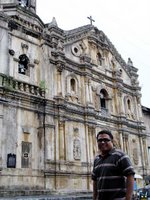 From Paete, we moved to the next town, Pakil. This town has an equally impressive church which houses the Nuestra Señora de los Dolores de Turumba. We felt bad that just two hours before we arrived, there was a pistang lupi which are festivities of the Turumba festival, which is done seven times from March to May. Sigh! That would have made our visit perfect! The image is brought around on an anda, accompanied by street dancing by devotees from all over.
From Paete, we moved to the next town, Pakil. This town has an equally impressive church which houses the Nuestra Señora de los Dolores de Turumba. We felt bad that just two hours before we arrived, there was a pistang lupi which are festivities of the Turumba festival, which is done seven times from March to May. Sigh! That would have made our visit perfect! The image is brought around on an anda, accompanied by street dancing by devotees from all over. The interior of the church was just marvelous! It's one of my favorites in the Southern Tagalog if you ask me. And the interior looked as if it were recently restored. We found out that efforts to restore it was a local initiative. I hope other towns around the country follow suit. When priests stop renovating heritage churches according to their whims and caprices, that would be the day! The CBCP should give its Commission on Church Heritage more teeth to control the tasteless damage done by many priests. And no church more than 50 years old should be touched without the go signal of the commission.
The interior of the church was just marvelous! It's one of my favorites in the Southern Tagalog if you ask me. And the interior looked as if it were recently restored. We found out that efforts to restore it was a local initiative. I hope other towns around the country follow suit. When priests stop renovating heritage churches according to their whims and caprices, that would be the day! The CBCP should give its Commission on Church Heritage more teeth to control the tasteless damage done by many priests. And no church more than 50 years old should be touched without the go signal of the commission.On the way back, we passed by the old church of Kalayaan in Longos. The old name of the town was actually Longos but this was changed to Kalayaan when they moved the seat of government to a different barangay. The church was right along the shores of Laguna de Bay and was well-preserved.
 Since it was getting late, we decided to go straight to Lucban where we were to spend the night. Accomodations were graciously taken care of by the parish. The choir of Holy Angel University was doing a concert that night so they were staying at the old convent. Our group was housed in a charming resthouse owned by a friend of the parish. For dinner, we had traditional Lucban food which included pancit habhab, tamales, Lucban tikoy and espasol.
Since it was getting late, we decided to go straight to Lucban where we were to spend the night. Accomodations were graciously taken care of by the parish. The choir of Holy Angel University was doing a concert that night so they were staying at the old convent. Our group was housed in a charming resthouse owned by a friend of the parish. For dinner, we had traditional Lucban food which included pancit habhab, tamales, Lucban tikoy and espasol.After watching the concert and going around the stalls set-up for the Pahiyas festival, we went back to the resthouse since we had to wake up early. The procession of San Isisdro Labrador was at 7 a.m.


